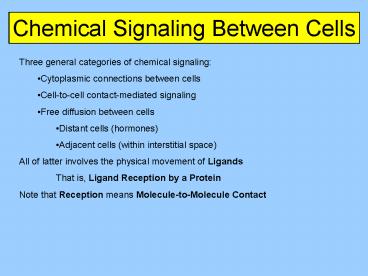Chemical Signaling Between Cells - PowerPoint PPT Presentation
1 / 43
Title:
Chemical Signaling Between Cells
Description:
We also will not dwell on why and how a given cell released a given signal ... Reception of extracellular signal by cell ... entirely within receiving cell ... – PowerPoint PPT presentation
Number of Views:300
Avg rating:3.0/5.0
Title: Chemical Signaling Between Cells
1
Chemical Signaling Between Cells
- Three general categories of chemical signaling
- Cytoplasmic connections between cells
- Cell-to-cell contact-mediated signaling
- Free diffusion between cells
- Distant cells (hormones)
- Adjacent cells (within interstitial space)
- All of latter involves the physical movement of
Ligands - That is, Ligand Reception by a Protein
- Note that Reception means Molecule-to-Molecule
Contact
2
Chemical Signaling Between Cells
3
Long-Distance Diffusion
4
Local Diffusion
e.g., Histamine released from damaged cells in
inflammation
e.g., Interferon release by viral-infected cells
5
Local Diffusion
6
Signal-Transduction Emphasis
This chapters emphasis is on signals that are
released from one cell and allowed to freely
diffuse to a second (or more) recipient
cell(s) These communications are deliberately
initiated, received, and interpreted in order to
increase the physiological coordination of the
cells in multicellular organisms We will consider
in particular those events that follow the
reception of chemical signals We will not dwell
on the purpose of the signal We also will not
dwell on why and how a given cell released a
given signal
7
Three Stages of Signal Transduction
- Reception of extracellular signal by cell
- Transduction of signal from outside of cell to
inside of celloften multi-stepped - Note not necessarily transduction of ligand
- Cellular Response
- Response is inititiated and/or occurs
entirely within receiving cell
8
Three Stages of Signal Transduction
9
Three Stages
2a. Transduction
2b. Transduction
2c. Transduction
2d. Transduction
Responses usually involve increasing or
decreasing some Proteins Function
10
Three Stages
1. Reception
2a. Transduction
2b. Transduction
3. Response
11
Various Responses
Note that more than one response can result from
the reception of a single ligand
12
Various Responses
13
Ligands
e.g., nitric oxide
e.g., steroid hormones
14
Intracellular Reception
15
Extracellular Reception
e.g., insulin
e.g., epinephrine
16
Examples of Surface Receptors
17
G Protein-Linked Receptors
18
G Protein-Linked Receptors
19
G Protein-Linked Receptors
20
G Protein-Linked Receptors
21
G Protein-Linked Receptors
the more ligand binding, the greater the cellular
response
note how activation is reversible
22
G Protein-Linked Receptors
23
G Protein-Linked Receptors
24
G Protein-Linked Receptors
25
G Protein-Linked Receptors
note how activation is reversible
26
G Protein-Linked Receptors
27
Protein Kinase Phosphatase
28
Tyrosine Kinase Receptors
- Note steps involved
- Ligand Reception
- Receptor Dimerization
- Catalysis (Phosphorylization)
- Subsequent Protein Activation
- Further Transduction
- Response
29
Tyrosine Kinase Receptors
30
Ion-Channel Receptors
31
Signal Amplification (Cascade)
32
Phosphorylation Cascade
- This reversibility contributes to the dynamic
nature of cells - A protein that is activated by a Protein Kinase
in turn is inactivated by a Protein Phosphatase - This means that the effect of signals cant last
forever - For the cellular response to continue, more
signal must be received
33
Phosphorylation Cascade
34
Epinephrine ? Glycogen Breakdown
100 molecules 102 molecules 104 molecules 104
molecules 105 molecules 106 molecules
108 mol Glu-1-Phosphate
35
Second Messengers
36
Cyclic AMP (cAMP) 2nd Messenger
37
Inositol Triphosphate 2nd Messenger
38
Transduction Pathway Cross-Talk
39
Specificity of Cell Signaling
- Note how same ligand gives rise to different
responses - Cells differ in terms of their proteins
- Different proteins respond differently to the
same environental signals - (note, though, same receptors, different relay)
- Different cells behave differently because some,
but not all proteins can differ between cell types
40
Link to Next Presentation
41
Acknowledgements
biology.ucf.edu/courses/bsc2010/08-2010C-02.PPT ww
w.aw.com/bc/ppt/marieb_ap/chap03c.ppt http//zeus.
uwindsor.ca/courses/biology/zielinski/204/comm1.pp
t http//vaccine.chonbuk.ac.kr/images/cell/Chapter
201520Cell.ppt http//faculty.uca.edu/jmurray/B
IOL1440/lec/lec15.ppt \http//www.rpi.edu/dept/bcb
p/molbiochem/MBWeb/mb1/part2/7-signal.ppt http//w
ww.rpi.edu/dept/bcbp/molbiochem/MBWeb/mb1/part2/9-
glycogen.ppt http//homepage.smc.edu/chen_thomas/B
io21/Chpt201120Cell20Comm.ppt
42
G Protein-Linked Receptors
43
G Protein-Linked Receptors































